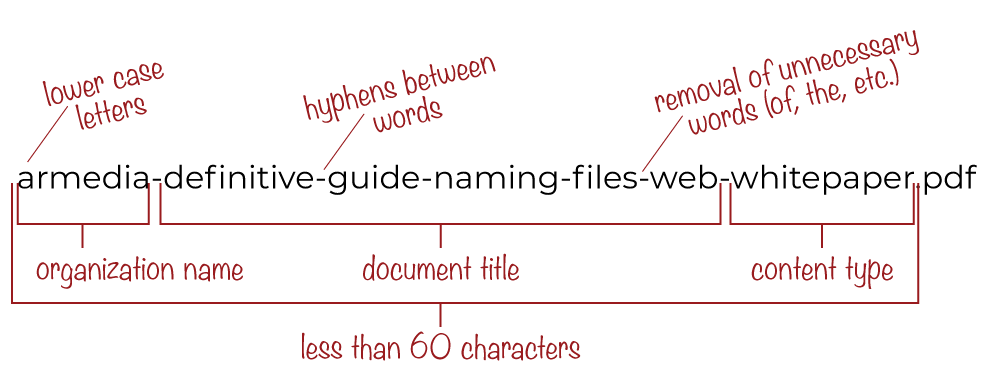Definitive Guide to Naming Files on the Web
Definitive Guide to Naming Files on the Web
Lots of people don’t give file names a second thought. I mean, who cares if my PDF is titled “Plz read & share this#my PDF_v15pdf.pdf”? Well, Google cares for one. And prospective customers may care too.
With the advent of content management platforms like Wordpress and Drupal, just about anyone can manage websites and upload files. It’s important to set a consistent standard across your organization for file naming, both to promote your brand and to be more attractive to search engine indexing.
There’s no real “art” to naming files, but it does require some thought and organization. You should strive to develop a consistent file naming convention for everything that you put on the web – from web site pages, to images, to downloadable files like PDFs and PPTs. Though these tips work for all types of files, let's focus on file naming conventions for downloadable files.
Here is what I would consider a perfect document file name.

Here are my tips to achieving file naming nirvana:
DO. NOT. USE. SPACES.
Why the all caps? Because this is my biggest pet peeve about file names on the web. In the early days of the Internet (yes, I am that old), if there was a space in the file name you couldn’t link to it. You’d just get a 404 error. Web browsers are more forgiving these days, but those spaces get converted to ASCII when you link to them, adding ugly and unreadable characters into the filename.


So, what should you do instead? Use hyphens. Remove each space in the filename and replace it with a hyphen, like this:


Why hyphens instead of underscores?
In the example above, I suggested using hyphens – and only hyphens – to replace the spaces in your file names, but many people believe underscores look more natural, like the space is still there between words. The reason to choose hyphens over underscores is SEO.
It is easier for Google to “read” a URL with hyphens than one with underscores while indexing your site. Google counts a hyphen as a word separator but it ignores underscores. So, if you name your file best_eatery.pdf, Google will read it as “besteatery” which is not really a word. But if you name it best-eatery.pdf, Google will recognize it as “best eatery.” This will improve the search engine ranking for that content.
Avoid special characters
Much like spaces, punctuation and other special characters get converted to ASCII code on the web, making for ugly file names. Even worse, there are several characters reserved for URLs that could “break” the link and make the document inaccessible. Though most modern browsers can accommodate this, you should avoid using these characters in file names:
# pound
% percent
& ampersand
{ left curly bracket
} right curly bracket
\ back slash
< left angle bracket
> right angle bracket
* asterisk
? question mark
/ forward slash
blank spaces
$ dollar sign
! exclamation point
' single quotes
" double quotes
: colon
@ at sign
+ plus sign
` backtick
| pipe
= equal sign
Make it readable
You should clearly state what the document is in the file name and make it as readable as possible. Avoid abbreviating words and make sure that the file name reflects the title of the document.


Avoid version numbers, dates or “FINAL”
You see it all the time. You download a file whose name ends with something like “v2.pdf,” “FINAL.pdf,” or “feb21.pdf.” Forgetting to remove these appendages is sloppy and makes you look unprofessional. It also complicates revising and replacing a file when you correct an error of if there is an updated version.
If “v2” is published and has been indexed by Google, then when “v3” comes out it has to compete with its older version in search engine rankings. If you remove the “v2” version, you now have to create a redirect from the old file name to the new one or get a 404 when someone clicks on that link. However, if you remove the versioning at the end, you can just replace the file on your website as needed.
This is not to be confused with a documented release or having an internal coding system. If your document is relating to version 2 of a software suite, then that is part of the product name, not the version of the document itself. Likewise, if you have an internal coding system for documentation, like adding a reference number, that's OK. No one else may understand it, but at least it's consistent.
Stick to lower case
Some servers interpret upper case and lower case characters differently. Traditionally, Unix and Linux environments treat upper case and lower case letters as distinct. So, if you upload a file with mixed case letters, it may be inaccessible if you typed it in as all lower case. Since over 90% of all websites run on the Linux platform, case sensitivity is important to recognize.
Include your organization’s name
This one is often overlooked. You’ve been working on a document called “Jelly Bean Flavors Ranked” for a while now. You save the document as a PDF and post to your website with the file name “jelly-bean-flavors-ranked.pdf.” Looks good, right? You converted spaces to hyphens, kept it short, and used lower case letters.
A web visitor downloads it, but now that it's on their computer, there is no indication that this PDF came from you. Then, Google indexes your site and picks up the new PDF to add to their search algorithm. Instead of “company-name-jelly-bean-flavors-ranked.pdf” getting indexed, “jelly-bean-flavors-ranked.pdf” is indexed. In both of these cases, you’ve missed an opportunity to promote your brand and solidify ownership of that content.
Consistently label
Most organizations have several types of content they publish and promote – white papers, case studies, technical briefs, transcripts, etc. Be sure to include the type of document in the file name. For example:
- company-name-document-title-whitepaper.pdf
- company-name-document-title-case-study.pdf
- company-name-document-title-ebook.pdf
- company-name-document-title-tech-brief.pdf
Keep it short
Strive to have no more than 60 characters in your file name. I know, I just said to add your company name and document type, so keeping the file name short and understandable with those additions may be difficult. Focus on only the most important words in the document’s title to include in the file name. You can skip articles like "the", "a", "of" and "in" to save space.
Putting it all together
Once you’ve determined a file naming convention that works for you, make sure to document that in your organization’s style guide. What you choose for your file naming convention is just as much a part of your organization’s brand as the logo and messaging. Also, make sure to communicate and train any staff that upload files to your website on proper file naming procedures.


